经济学原理习题15-1
《经济学原理》习题(附答案)
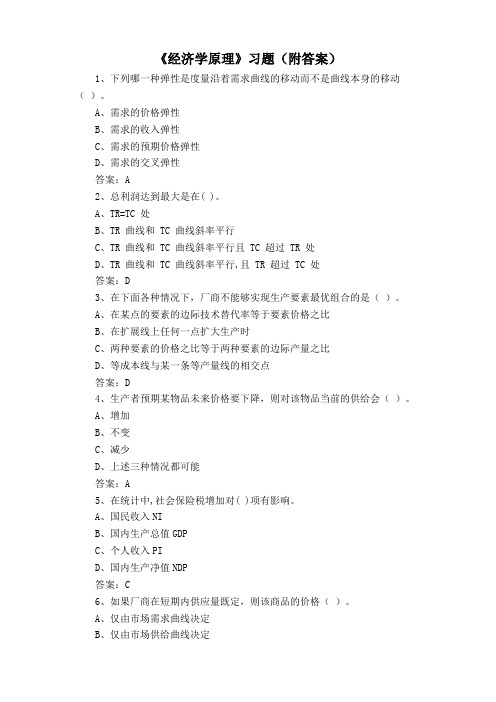
《经济学原理》习题(附答案)1、下列哪一种弹性是度量沿着需求曲线的移动而不是曲线本身的移动()。
A、需求的价格弹性B、需求的收入弹性C、需求的预期价格弹性D、需求的交叉弹性答案:A2、总利润达到最大是在( )。
A、TR=TC 处B、TR 曲线和 TC 曲线斜率平行C、TR 曲线和 TC 曲线斜率平行且 TC 超过 TR 处D、TR 曲线和 TC 曲线斜率平行,且 TR 超过 TC 处答案:D3、在下面各种情况下,厂商不能够实现生产要素最优组合的是()。
A、在某点的要素的边际技术替代率等于要素价格之比B、在扩展线上任何一点扩大生产时C、两种要素的价格之比等于两种要素的边际产量之比D、等成本线与某一条等产量线的相交点答案:D4、生产者预期某物品未来价格要下降,则对该物品当前的供给会()。
A、增加B、不变C、减少D、上述三种情况都可能答案:A5、在统计中,社会保险税增加对( )项有影响。
A、国民收入NIB、国内生产总值GDPC、个人收入PID、国内生产净值NDP答案:C6、如果厂商在短期内供应量既定,则该商品的价格()。
A、仅由市场需求曲线决定B、仅由市场供给曲线决定C、由市场需求曲线和供给曲线共同决定D、以上任一条都不能决定答案:A7、按国民收入核算体系,在一个只有家庭、企业和政府构成的三部门经济中,一定有( )。
A、家庭储蓄加折旧等于总投资加政府购买支出B、家庭储蓄加税收等于总投资加政府购买支出C、家庭储蓄等于总投资D、家庭储蓄等于净投资答案:B8、微观经济学是经济学的一个分支,主要研究()。
A、市场经济B、个体行为C、总体经济活动D、失业和通货膨胀等答案:B9、劳动(L)的总产量下降时()。
A、MPL为负B、APL是递增的C、APL为零D、MPL为零答案:A10、基数效用与序数效用的主要差别在于两种商品的( )。
A、边际替代率是否不变B、边际替代率是否递增C、效用是否可加D、边际替代率是否递减答案:C11、稀缺资源的含义是指()。
经济学第15章答案

第一章【参考答案】一、名词解释:(请各位学员自己参照教材整理)二、简答题1、在西方经济学中,成本一般指厂商在组织生产活动中所使用的各种生产要素的价格,即为获取一定经济成果而支出的一切费用,它不仅包括原材料、燃料、动力、辅助材料、固定资产折旧、员工工资等费用,还包括资本的保持——利息、土地租金——地租、——企业家才能的报酬——利润(企业家才能的报酬——利润,是指生产成本中的“正常利润”)。
这样的成本也称为生产费用。
而机会成本则是指一定的生产要素被用于生产某种产品时所放弃的、用于生产另一种产品时可能获得的最大收益。
例如,企业主用自己的资金办企业的机会成本就等于他把这笔资金借给别人可能得到的利息。
企业主自己当企业经理的机会成本时他到别处就业可能得到的报酬。
生产A产品的机器转向生产B产品,B产品的机会成本时生产A产品时得到的利润收入。
显然,生产费用所体现的成本与机会成本是有区别的,因为机会成本并不是生产中直接支出的生产费用。
但二者也是有联系的,考虑生产成本和机会成本都是为了考察利润或者说经济活动的效益,如果B产品的生产成本(生产费用)不变,生产A 产品的成本上升从而获得的利润下降,则B产品的机会成本下降;生产一种物品的机会成本越高,说明这种生产的效率或者说效益就越低。
相反,生产一种有用物品的机会成本越低,表明这种物品生产上的效率就越高。
2、“技术效率”和“经济效率”都是生产效率问题,但前者纯粹是从生产技术的角度考虑技术的可行性问题,比方说生产一定产品,应当投入多少劳动力,多少设备,但经济效率还需要考虑生产要素的相对价格、如何使用生产要素次啊能使得生产成本更低。
技术上有效率的不一定是经济上有效率的。
例如,某一工程仅从技术角度考虑的话,则投入一定数量劳动力再加上少量先进的设备就是有效率的。
然而,如果劳动力工资很低,而先进设备却十分昂贵,则从经济效率考虑,宁可更多用劳动力,用些简陋的老设备代替先进设备,这样会更合算些。
经济学原理习题及答案
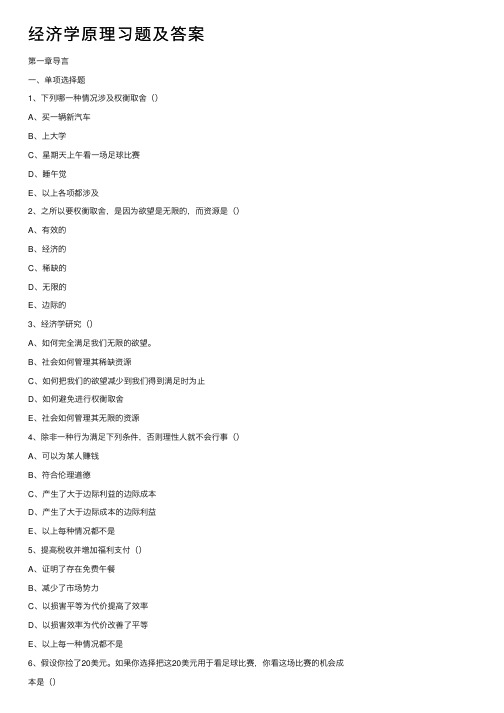
经济学原理习题及答案第⼀章导⾔⼀、单项选择题1、下列哪⼀种情况涉及权衡取舍()A、买⼀辆新汽车B、上⼤学C、星期天上午看⼀场⾜球⽐赛D、睡午觉E、以上各项都涉及2、之所以要权衡取舍,是因为欲望是⽆限的,⽽资源是()A、有效的B、经济的C、稀缺的D、⽆限的E、边际的3、经济学研究()A、如何完全满⾜我们⽆限的欲望。
B、社会如何管理其稀缺资源C、如何把我们的欲望减少到我们得到满⾜时为⽌D、如何避免进⾏权衡取舍E、社会如何管理其⽆限的资源4、除⾮⼀种⾏为满⾜下列条件,否则理性⼈就不会⾏事()A、可以为某⼈赚钱B、符合伦理道德C、产⽣了⼤于边际利益的边际成本D、产⽣了⼤于边际成本的边际利益E、以上每种情况都不是5、提⾼税收并增加福利⽀付()A、证明了存在免费午餐B、减少了市场势⼒C、以损害平等为代价提⾼了效率D、以损害效率为代价改善了平等E、以上每⼀种情况都不是6、假设你捡了20美元。
如果你选择把这20美元⽤于看⾜球⽐赛,你看这场⽐赛的机会成本是()A、没有,因为你捡到了钱B、20美元(因为你可以⽤这20美元买其他东西)C、20美元(因为你可以⽤这20美元买其他东西)加上你⽤于看⽐赛的时间的价值D、20美元(因为你可以⽤这20美元买其他东西)加上你⽤于看⽐赛的时间的价值,再加上你在看⽐赛中买饭的成本E、以上每⼀项都不是7、对外贸易()A、使⼀国能以低于⾃⼰在国内⽣产⼀切东西时的成本拥有种类更多的物品B、使⼀国可以避免权衡取舍C、使⼀国可以更平等D、提⾼了资源的稀缺性E、以上每⼀项都不是8、由于⼈们会对激励作出反应,如果会计师的平均薪⽔增加50%,⽽教师的平均⼯资增加20%,我们可以预期()A、学⽣将从教育专业转向会计专业B、学⽣将从会计专业转向教育专业C、上⼤学的学⽣少了D、以上每⼀项都不是9、以下哪⼀种活动最可能产⽣外部性()A、学⽣坐在家⾥看电视B、学⽣在宿舍⾥聚会C、学⽣为了娱乐⽽读⼩说D、学⽣在学⽣会吃汉堡包10、以下哪⼀种东西产⽣的外部性能⼒最⼩()A、⾹烟B、⾳响设备C、防⽌疾病的疫苗D、教育E、⾷物11、以下哪⼀种情况描述了最⼤的市场势⼒()A、⼀个农民对⾕物价格的影响B、沃尔沃对汽车价格的影响C、微软对台式电脑操作系统价格的影响D、⼀个学⽣对⼤学学费的影响12、下列哪⼀种关于市场经济的表述是正确的()A、市场参与者仿佛由⼀只“看不见的⼿”指引⾏事,产⽣了使社会福利最⼤化的结果B、税收有助于沟通⽣产者与消费者的成本与利益C、在有⾜够⼤的电脑时,中央计划者可以⽐市场更有效地指导⽣产D、市场体制的⼒量倾向于在消费者平等地分配资源13、美国⼯⼈享有⾼⽣活⽔平是因为()A、美国的公会维护了⾼⼯资B、我们保护⾃⼰的⼯作免受国外竞争C、美国有⾼的最低⼯资D、美国⼯⼈的⽣产率⾼E、以上每⼀项都不是14、⾼⽽持久的通货膨胀原因是()A、公会使⼯资增加的太多了B、⽯油输出国组织使⽯油价格上升的太多了C、政府增加的货币量太多了D、管制使⽣产成本增加的太多了15、在短期内()A、通货膨胀提⾼会暂时增加失业B、通货膨胀下降会暂时增加失业C、通货膨胀和失业是⽆关的D、经济周期被消除了E、以上每⼀项都不是16、你根据销售额为2000美元的估算花1000美元盖了⼀个热狗店。
经济学原理习题与答案

经济学原理习题与答案经济学原理习题与答案第1章绪论一、单项选择题1.经济学可定义为( C )A、政府对市场制度的干预B、企业取得利润的活动C、研究如何最合理地配置稀缺资源于诸多用途D、人们靠收入生活2.经济学研究的基本问题是( D )A、怎样生产B、生产什么,生产多少C、为谁生产D、以上都包括3.说“资源是稀缺的”是指( B )A、世界上大多数人生活在贫困中B、相对于资源的需求而言,资源总是不足的C、资源必须保留给下一代D、世界上资源最终将由于生产更多的物品和劳务而消耗光4.人们在进行决策时,必须作出某种选择,这是因为( B )A、选择会导致短缺B、人们在进行决策时面临的资源是有限的C、人是自私的,所作出的选择会实现自身利益的最大化D、个人对市场的影响是微不足道的5.下列问题( C )是经济学研究不会涉及的问题A、在稀缺资源约束条件下,实现资源有效配置的方法B、如何实现中国人均收入翻两番C、中国传统文化的现代化问题D、充分就业和物价水平的稳定6.一国生产可能性曲线以内的一点表示( B )A、通货膨胀B、失业或资源没有被充分利用C、该国可利用的资源减少以及技术水平降低D、一种生产品最适度水平7.下列各项中( C )会导致一国生产可能性曲线向外移动A、失业B、通货膨胀C、有用性资源增加或技术进步D、消费品生产增加,资本物品生产下降8.下列命题中( C )不是实证经济学命题A、1982年8月联储把贴现率降到10%B、1981年失业率超过9%C、联邦所得税对中等收入家庭是不公平D、社会保险税的课税依据已超过30 000美元9.下列( B )是规范经济学的说法A、医生挣的钱比蓝领工人多B、收入分配中有太多的不公平现象C、从1999年开始,中国的物价水平基本保持稳定状态,这一现象也许会保持到2005年D、如果在20世纪80年代中期你购买了微软公司的1000股股票,现在你愿意出售的话,你肯定赚不少钱10.由市场配置资源意味着( B )A、所有的人都会得到他想要的东西B、资源的配置是由市场机制实现的C、政府能够决定谁获得多少消费品D、要得到急需的物品你只能“走后门”11.西方学者认为现代美国经济是一种( C )A、完全的自由放任经济制度B、严格的计划经济制度C、混合资本主义市场经济制度D、自给自足制度二、判断正误1.只有落后国家才存在资源的稀缺性和供给的短缺现象。
《经济学原理》习题+参考答案
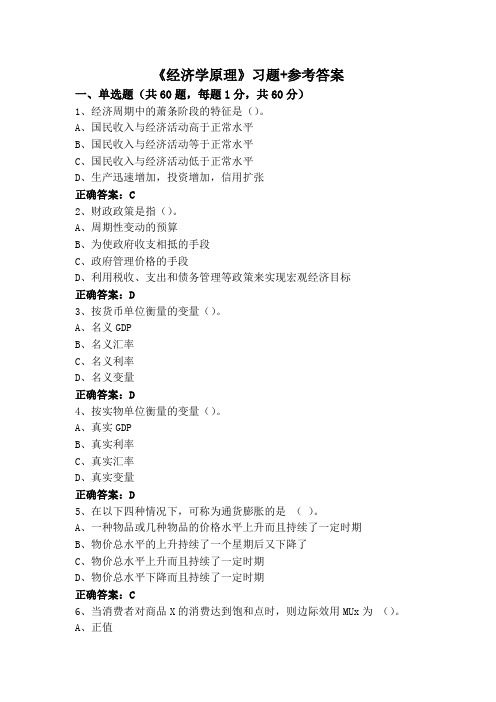
《经济学原理》习题+参考答案一、单选题(共60题,每题1分,共60分)1、经济周期中的萧条阶段的特征是()。
A、国民收入与经济活动高于正常水平B、国民收入与经济活动等于正常水平C、国民收入与经济活动低于正常水平D、生产迅速增加,投资增加,信用扩张正确答案:C2、财政政策是指()。
A、周期性变动的预算B、为使政府收支相抵的手段C、政府管理价格的手段D、利用税收、支出和债务管理等政策来实现宏观经济目标正确答案:D3、按货币单位衡量的变量()。
A、名义GDPB、名义汇率C、名义利率D、名义变量正确答案:D4、按实物单位衡量的变量()。
A、真实GDPB、真实利率C、真实汇率D、真实变量正确答案:D5、在以下四种情况下,可称为通货膨胀的是()。
A、一种物品或几种物品的价格水平上升而且持续了一定时期B、物价总水平的上升持续了一个星期后又下降了C、物价总水平上升而且持续了一定时期D、物价总水平下降而且持续了一定时期正确答案:C6、当消费者对商品X的消费达到饱和点时,则边际效用MUx为()。
A、正值B、不确定C、零D、负值正确答案:C7、要缓和结构性失业,应该实行()。
A、人力政策B、财政政策C、收入政策D、货币政策正确答案:A8、中央银行在公开市场卖出政府债券是企图()。
A、减少流通中基础货币以紧缩货币供给B、收集一笔资金帮助政府弥补财政赤字C、通过买卖债券获得差价利益D、减少商业银行在中央银行的存款正确答案:D9、公共产品具有以下哪个特征()。
A、排他性B、竞争性C、非排他性和非竞争性D、以上全对正确答案:C10、在总需求不变时,短期总供给的增加会引起 ( )。
A、国民收入减少,价格水平下降B、国民收入增加,价格水平上升C、国民收入减少,价格水平上升D、国民收入增加,价格水平下降正确答案:D11、投资乘数等于()。
A、收入变化除以投资变化B、投资变化除以收入变化C、MPC的倒数D、1-MPS的倒数正确答案:D12、下面哪一项不是政府职能()A、在市场上决定产品的价格B、提供公共物品C、用行政与法律手段解决市场失灵D、对自然垄断实行价格管制正确答案:A13、货币数量论认为,可得到的()决定物价水平。
曼昆经济学原理11章--15章课后答案

第十一章公共物品和共有资源复习题1.解释一种物品有“排他性”的含义。
解释一种物品有“竞争性”的含义。
比萨饼有排他性吗?有竞争性吗?答:一种物品具有“排他性”是指可以阻止一个人使用一种物品时该物品的特性。
一种物品有竞争性是指一个人使用一种物品减少其他人使用该物品的特性。
比萨饼有排他性,只要不卖给某人比萨饼就可以阻止他使用。
比萨饼也有竞争性,一个人多吃一块比萨饼,会使其他人少享受一块。
2.给公共物品下定义并举出一个例子。
私人市场本身能提供这种物品吗?并解释之。
答:公共物品是既无排他性又无竞争性的物品,私人市场本身不能提供这种物品。
公共物品没有排他性,因此,无法对公共物品的使用者收费,在私人提供这种物品时就存在搭便车的激励,从而使私人提供者无利可图。
3.什么是公共物品的成本一收益分析?为什么它是重要的?进行这种分析困难吗?答:公共物品的成本一收益分析是提供一种公共物品的社会成本和社会收益比较的研究。
只有比较提供一种公共物品的成本与收益,政府才能决定是否值得提供这种公共物品。
公共物品的成本一收益分析是一项艰苦的工作。
因为所有的人都可以免费使用一种公共物品,没有判断这种公共物品价值的价格。
简单地问人们,他们对一种公共物品的评价是多少是不可靠的。
那些受益于该公共物品的人有夸大他们的利益的激励。
那些受害于该公共物品的人有夸大他们成本的激励。
4.给共有资源下定义并举出一个例子。
没有政府干预,人们使用这种物品会太多还是太少?为什么?答:共有资源是有竞争性但无排他性的物品。
没有政府干预,人们使用这种物品会太多。
因为不能向使用共有资源的人收费,而且,一个人对共有资源的使用会减少其他人的使用,所以,共有资源往往被过度使用。
问题与应用1.本书认为公共物品和共有资源都涉及外部性。
A.与公共物品相关的外部性一般是正的还是负的?用例子来回答。
自由市场的公共物品量一般是大于还是小于有效率的数量?答:与公共物品相关的外部性一般是负的。
曼昆《经济学原理(微观经济学分册)》(第6版)笔记和课后习题(含考研真题)详解-第15章 垄 断【圣

价格。
(3)利润最大化
垄断厂商为了获得最大的利润,也必须遵循 MR MC 的原则。
在垄断市场上,价格大于边际成本。因而,对于垄断企业有: P MR MC
在垄断企业选择了使边际收益等于边际成本的产量之后,就可以用需求曲线找出与那
种产量对应的价格。
(4)垄断利润
利润等于总收益( TR )减去总成本( TC )
圣才电子书
十万种考研考证电子书、题库视频学习平 台
第 15 章 垄 断
15.1 复习笔记
1.垄断 (1)垄断市场指整个行业中只有一个厂商的市场组织。具体地说,垄断市场的条件 主要有这样三点:第一,市场上只有一个厂商生产和销售商品;第二,该厂商生产和销售 的商品没有任何相近的替代品;第三,其他任何厂商进入该行业都极为困难或不可能。 (2)产生垄断的原因 垄断的基本原因是进入壁垒,即垄断者能在其市场上保持唯一卖者的地位,是因为其 他企业不能进入市场并与之竞争。进入壁垒又有三个主要来源: ①垄断资源。生产所需要的关键资源由一家企业拥有。 ②政府管制。政府给予一个企业排他性地生产某种产品或劳务的权利。 ③自然垄断。某个企业能以低于大量生产者的成本生产产品。
1 / 34
圣才电子书
十万种考研考证电子)曲线也是向右下方倾斜的,且位于平均收益( AR )曲线
的下方,这表示在每一个销售量上厂商的边际收益都小于平均收益。之所以出现 MR AR ,
是因为只要平均量下降,边际量就总是小于平均量。
如 15-3(b)所示,每位对物品评价大于边际成本的顾客都买到了物品,并支付了其支付
意愿的价格。所有互惠的贸易都进行了,没有无谓损失,垄断生产者得到了以利润形式表
示的市场的全部剩余。
图 15-3 有无价格歧视时的福利
《经济学原理》部分练习题参考答案1

《经济学原理》部分练习题参考答案(微观部分)一、名词解释:1、资源的稀缺性:是指相对于人类无限的欲望而言,人的需求具有无限增长和扩大的趋势,为了满足这种需求就需要更多的物品和劳务,从而需要更多的资源,而在一定时间与空间范围内资源总是有限的,相对不足的资源与人类绝对增长的需求相比造成了资源的稀缺性。
2、微观经济学:是研究社会中单个经济单位的经济行为,以及相应的经济变量的单项数值如何决定的经济学说,亦称市场经济学或价格理论。
3、宏观经济学:以整个国民经济为研究对象,通过研究经济中各有关总量的决定及其变化,来说明资源如何才能得到充分利用。
4、需求:指市场上的消费者在一定时期内,在每一可能价格水平上愿意而且能够购买某种商品的数量。
5、供给:是指市场上的卖方在一定时期内,在每一可能价格水平上愿意而且能够出售某种商品的数量。
6、需求函数:是表示一种商品的需求数量和影响该需求数量的各种因素之间的相互关系。
7、供给函数:把影响供给量的所有因素作为自变量,把供给量作为因变量,则可以用函数关系来表达供给量和这些影响供给量的因素之间的依存关系,这种函数被称为供给函数。
8、需求定理:在影响需求的其他因素不变的情况下,某一商品的价格下降,需求量就增加,而商品的价格上升,该商品的需求量就减少,商品的需求量和其价格之间的这种关系称为需求定理。
9、供给定理:某一商品的价格越低,商品的供给量越小,商品的价格越高,该商品的供给量越大,这就是供给定理。
10、供求定理:需求的变动引起均衡价格与均衡数量同方向变动,供给的变动引起均衡价格反方向变动,均衡数量同方向变动。
11、均衡价格:就是当商品的供给量和需求量恰好相等时的价格。
此时,价格既不上升也不下降,保持相对稳定状态。
12、最高限价:也被称为限制价格,是政府所规定的某种产品的最高价格;最高限价总是低于市场均衡价格。
13、最低限价:也称为支持价格,是政府所规定的某种产品的最低价格。
最低限价总是高于市场均衡价格。
《经济学原理》练习题、答案(可编辑修改word版)

《经济学原理》练习题、答案(可编辑修改word版)《经济学原理》总目录第一篇导论第一章导论第二篇微观经济理论第二章需求、供给与均衡第三章消费者行为理论第四章生产者行为理论第五章产品市场理论第六章生产要素理论第七章微观经济政策第三篇宏观经济理论第八章国民收入的核算与决定理论第九章失业与通货膨胀理论第十章经济周期与经济增长理论第十一章宏观经济政策第十二章开放经济第一章导论一、单项选择1、作为经济学的两个组成部分,微观经济学与宏观经济学是()A.互相对立的B.没有任何联系的C.相互补充的D.部分联系的2、古典经济学家亚当·斯密所谓的“看不见的手”是指()A.技术B.信息C.价格D.行政命令3、经济学研究的基本问题是()A.生产什么B.如何生产C.为谁生产D.以上都是4、资源的稀缺性是指()。
A.世界上的资源最终会由于人们生产更多的物品而消耗光B.相对于人们无穷的欲望而言,资源总是不足的C.生产某种物品所需资源的绝对数量很少D.由于存在资源浪费而产生的稀缺5、微观经济学解决的问题是()。
A.资源配置B.资源利用C.市场出清D.完全理性6、宏观经济学的中心理论是()。
A.失业理论B.通货膨胀理论C.国民收入决定理论D.经济增长理论7、关于实证经济学与规范经济学说法正确的是()A.两者并不是绝对相互排斥的,而应当是相互补充的。
B.规范经济学是以实证经济学为基础,而实证经济学则是以规范经济学作为指导的。
C.一般来说,越是具体的问题,实证的成分越多,而越是高层次的、决策性的问题,就越具有规范性。
D.以上说法都对二、多项选择1、微观经济学的主要内容包括()A.体格决定理论B.消费者行为理论C.生产者行为理论D.市场理论和分配理论等2、宏观经济学的基本内容有()A.宏观经济政策B.经济周期与增长理论C.国民收入决定理论D.失业与通货膨胀理论3、下列关于资源稀缺性的正确的说法有()A.资源稀缺性是相对于欲望的无限性而言的B.地球上的资源本来就少C.资源稀缺性存在于世界各地D.资源稀缺性存在于人类历史的各个时期三、判断题1、资源的稀缺性决定了资源可以得到充分的利用,不会出现资源浪费的现象。
曼昆《经济学原理(微观经济学分册)》(第6版)笔记(第15章 垄 断)

曼昆《经济学原理(微观经济学分册)》(第6版)第15章垄断复习笔记跨考网独家整理最全经济学考研真题,经济学考研课后习题解析资料库,您可以在这里查阅历年经济学考研真题,经济学考研课后习题,经济学考研参考书等内容,更有跨考考研历年辅导的经济学学哥学姐的经济学考研经验,从前辈中获得的经验对初学者来说是宝贵的财富,这或许能帮你少走弯路,躲开一些陷阱。
以下内容为跨考网独家整理,如您还需更多考研资料,可选择经济学一对一在线咨询进行咨询。
一、垄断产生的原因垄断企业是指一个没有相似替代品的产品的唯一卖者的企业。
垄断产生的基本原因是进入壁垒:垄断企业能在其市场上保持唯一卖者的地位,是因为其他企业不能进入市场并与之竞争。
进入壁垒有三个主要形成原因:第一,垄断资源:生产所需要的关键资源由单个企业所拥有;第二,政府管制:政府给予单个企业排他性地生产某种物品或劳务的权利;第三,生产流程:某个企业能以低于大量生产者的成本生产产品。
1.垄断资源垄断产生的最简单方法是单个企业拥有一种关键的资源。
垄断企业比竞争市场上任何一家企业有大得多的市场势力。
即使产品边际成本很低,垄断企业也可以利用市场势力也可以制定极高的价格。
虽然关键资源的排他性所有权是垄断的一个潜在起因,但实际上垄断很少产生于这种原因。
现实经济如此巨大,且资源由许多人拥有。
由于许多物品可以在国际上交易,它们的市场的自然范围往往很广泛。
因此,拥有没有相近替代品资源的企业的例子很少。
2.创造的垄断在许多情况下,垄断的产生是因为政府给予一个人或一个企业排他性地出售某种物品或劳务的权利,有时垄断产生于想成为垄断者的人的政治影响,还有些时候,政府也会出于公共利益而赋予某种垄断的权利。
专利法和版权法是两个重要的例子。
由于这些法律使一个生产者成为垄断者,所以也就使其价格高于竞争市场上的价格。
通过允许这些垄断生产者收取较高价格并赚取较多利润,这些法律也鼓励了一些合意的行为。
有关专利和版权的法律既有利益也有成本。
经济学原理 习题及答案

经济学原理习题及答案1 引论一、选择正确答案1.经济学可定义为()。
A.企业赚取利润的活动B.研究人们如何依靠收入生活的问题C.研究稀缺资源如何有效配置的问题D.政府对市场制度的干预2.“资源是稀缺”指的是()。
A.世界上的资源最终将被消耗尽B.资源是不可再生的C.资源必须留给下一代D.相对于需求而言,资源总是不足的3.一个经济体系必须回答的基本问题是()。
A.生产什么,生产多少B. 如何生产C.为谁生产D.以上都包括4.下列属于规范分析表述的是()。
A.鼓励私人购买汽车有利于促进我国汽车工业的发展B.随着收入水平的提高,拥有汽车的人会越来越多C.由于我国居民收入水平低,大多数人还买不起汽车D.个人汽车拥有量的增多,给我国居民的出行带来交通隐患5.下列属于实证分析表述的是()。
A.治理通货膨胀比减少失业更重要B.通货膨胀对经济发展有利C.通货膨胀对经济发展不利D.只有控制货币量才能抑制通货膨胀答案:1.C; 2.D; 3.D; 4.B; 5.A。
二、分析讨论1.如何理解西方经济学是一门考察稀缺的资源合理配置的科学。
答:西方经济学认为,人类的欲望和由此引起的对物品和劳务的需要是无限多样的,可是用来满足这些无限需要的手段即用来提供这些物品和劳务的生产资源是稀缺的。
这样,就产生了如何分配使用这些有限的资源来满足无限需要的问题,这就是“选择”,也就是“配置”资源的问题。
人类社会面临的经济问题就是如何把有限的资源合理地和有效率地分配使用于各种途径以满足人类无限多样的需要。
在市场经济中,资源的配置是通过市场价格机制来实现的。
生产什么、生产多少、如何生产、为谁生产,都是由市场价格决定的。
假若人类能无限量地生产出各种物品,或者人类的欲望能够完全得到满足,即在这样一个丰裕的伊甸园里,不存在稀缺物品,所有的物品都是免费的,像沙漠中的沙和海岸边的海水,价格和市场互不相关,那么经济学就无须存在了。
正是由于人类欲望的无限性和生产资源的有限性之间的矛盾才引起了人类的经济活动,西方经济学也就成为一门考察稀缺资源的配置的科学。
经济学原理习题及答案

经济学原理习题及答案(总127页) --本页仅作为文档封面,使用时请直接删除即可----内页可以根据需求调整合适字体及大小--经济学原理习题及答案1 引论一、选择正确答案1.经济学可定义为()。
A.企业赚取利润的活动B.研究人们如何依靠收入生活的问题C.研究稀缺资源如何有效配置的问题D.政府对市场制度的干预2.“资源是稀缺”指的是()。
A.世界上的资源最终将被消耗尽B.资源是不可再生的C.资源必须留给下一代D.相对于需求而言,资源总是不足的3.一个经济体系必须回答的基本问题是()。
A.生产什么,生产多少B. 如何生产C.为谁生产D.以上都包括4.下列属于规范分析表述的是()。
A.鼓励私人购买汽车有利于促进我国汽车工业的发展B.随着收入水平的提高,拥有汽车的人会越来越多C.由于我国居民收入水平低,大多数人还买不起汽车D.个人汽车拥有量的增多,给我国居民的出行带来交通隐患5.下列属于实证分析表述的是()。
A.治理通货膨胀比减少失业更重要B.通货膨胀对经济发展有利C.通货膨胀对经济发展不利D.只有控制货币量才能抑制通货膨胀答案:;;;;。
二、分析讨论1.如何理解西方经济学是一门考察稀缺的资源合理配置的科学。
答:西方经济学认为,人类的欲望和由此引起的对物品和劳务的需要是无限多样的,可是用来满足这些无限需要的手段即用来提供这些物品和劳务的生产资源是稀缺的。
这样,就产生了如何分配使用这些有限的资源来满足无限需要的问题,这就是“选择”,也就是“配置”资源的问题。
人类社会面临的经济问题就是如何把有限的资源合理地和有效率地分配使用于各种途径以满足人类无限多样的需要。
在市场经济中,资源的配置是通过市场价格机制来实现的。
生产什么、生产多少、如何生产、为谁生产,都是由市场价格决定的。
假若人类能无限量地生产出各种物品,或者人类的欲望能够完全得到满足,即在这样一个丰裕的伊甸园里,不存在稀缺物品,所有的物品都是免费的,像沙漠中的沙和海岸边的海水,价格和市场互不相关,那么经济学就无须存在了。
《经济学原理》练习题(含答案)
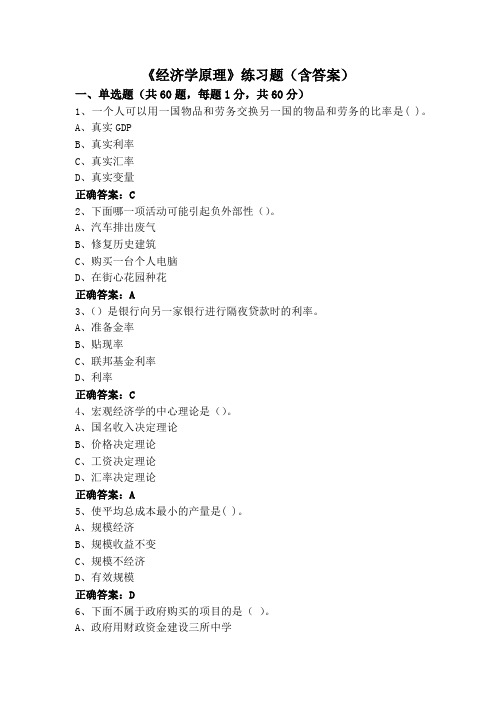
《经济学原理》练习题(含答案)一、单选题(共60题,每题1分,共60分)1、一个人可以用一国物品和劳务交换另一国的物品和劳务的比率是( )。
A、真实GDPB、真实利率C、真实汇率D、真实变量正确答案:C2、下面哪一项活动可能引起负外部性()。
A、汽车排出废气B、修复历史建筑C、购买一台个人电脑D、在街心花园种花正确答案:A3、()是银行向另一家银行进行隔夜贷款时的利率。
A、准备金率B、贴现率C、联邦基金利率D、利率正确答案:C4、宏观经济学的中心理论是()。
A、国名收入决定理论B、价格决定理论C、工资决定理论D、汇率决定理论正确答案:A5、使平均总成本最小的产量是( )。
A、规模经济B、规模收益不变C、规模不经济D、有效规模正确答案:D6、下面不属于政府购买的项目的是()。
A、政府用财政资金建设三所中学B、政府从国外购买一批武器C、政府给公务员发放工资D、政府为低收入家庭提供住房补贴正确答案:D7、长期生产水平有时称为()。
A、长期产量B、平均产量C、一般产量D、潜在产量正确答案:D8、下列哪一项计入GDP()。
A、购买一辆用过的自行车B、购买普通股票C、汽车制造厂买进十吨钢板D、银行向某企业收取一笔贷款利息正确答案:D9、宏观经济政策的目标是()。
A、充分就业和物价稳定B、充分就业和公平C、实现充分就业、物价稳定、经济增长和国际收支平衡D、物价稳定和经济增长正确答案:D10、()是人们可以把现在的购买力转变为未来的购买力的东西。
A、计价单位B、世界货币C、价值储藏D、交换媒介正确答案:C11、厂商获得最大利润的条件是()。
A、MR>MC的差额为最大B、MR=MCC、P>AC的差额为最大D、TR>TC的差额为最大正确答案:B12、下列哪一项不是GDP的组成部分()。
A、消费B、投资C、净出口D、储蓄正确答案:D13、下列不是解释总需求曲线向右下方倾斜的一项是()。
A、财富效应B、汇率效应C、物价水平D、利率效应正确答案:C14、等成本曲线平行向外移动表明( )。
经济学原理习题和习题答案

经济学原理习题和习题答案《经济学原理》练习题(微观经济学部分)第一章分析讨论题1. 经济学所描述的效率是什么,衡量效率的依据是什么,我们日常所认为的效率与经济学所认为有什么不同,2. 微观经济学与宏观经济学有什么区别,第二章一、名词解释需求需求函数供给供给函数均衡价格均衡数量价格机制支持价格限制价格弹性需求价格弹性恩格尔系数二、单项选择1. 在得出某种商品的个人需求曲线时,下列各种因素中除哪一种外均保持常数,( )。
A. 个人收入B. 其余商品价格C. 个人偏好D. 所考虑商品的价格2. 消费者预期某种商品的价格将要上升,那么对该商品当前需求会( )。
A. 减少 B. 增加C. 不变D. 上述三种情况都可能3. 一个商品价格下降对其互补品最直接的影响是( )。
A. 互补品的需求曲线向右移B. 互补品的需求曲线向左移动C. 互补品的供给曲线向右移动D. 互补品的价格上升4. 如果某种商品供给曲线的斜率为正,在保持其他因素不变的条件下,该商品价格的上升,导致( )。
. 供给增加 B. 供给量增加 AC. 供给减少D. 供给量减少5. 生产者预期某物品未来价格要下降,那么对该物品当前的供给会( )。
A. 增加 B. 减少C. 不变D. 上述三种情况都可能 6. 需求的价格弹性是指( )。
A. 需求函数的斜率B. 收入变化对需求的影响程度C. 消费者对价格变化的反映程度D. 以上说法都正确 7. 假定某商品的价格从10美元下降到9美元,需求量从70增加到75,则需求为( )。
缺乏弹性 B. 富有弹性 C. 单一弹性 D. 难以确定 A.8. 下列( )情况使总收益增加。
A. 价格上升,需求缺乏弹性B. 价格下降,需求缺乏弹性C. 价格上升,需求富有弹性D. 价格下降,需求富有弹性 9. 如果一种商品的价格变动5%,需求量因此变动2%。
那么( )。
A. 该商品需求富有价格弹性 B. 如果价格上升,收入会增加 C. 如果价格上升,收入会减少 D. 如果价格下降,收入会增加三、计算题QP,,2051. 已知某商品的需求函数为,供给函数为。
经济学原理课后习题+答案
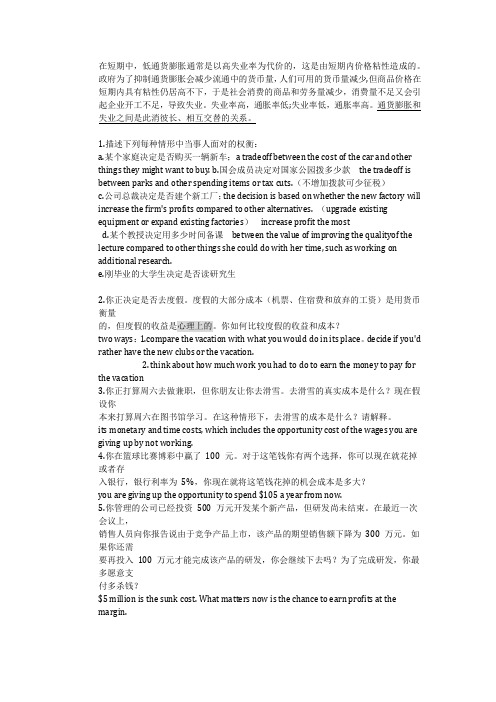
在短期中,低通货膨胀通常是以高失业率为代价的,这是由短期内价格粘性造成的。
政府为了抑制通货膨胀会减少流通中的货币量,人们可用的货币量减少,但商品价格在短期内具有粘性仍居高不下,于是社会消费的商品和劳务量减少,消费量不足又会引起企业开工不足,导致失业。
失业率高,通胀率低;失业率低,通胀率高。
通货膨胀和失业之间是此消彼长、相互交替的关系。
1.描述下列每种情形中当事人面对的权衡:a.某个家庭决定是否购买一辆新车;a tradeoff between the cost of the car and other things they might want to buy.b.国会成员决定对国家公园拨多少款the tradeoff is between parks and other spending items or tax cuts.(不增加拨款可少征税)c.公司总裁决定是否建个新工厂;the decision is based on whether the new factory will increase the firm's profits compared to other alternatives. (upgrade existing equipment or expand existing factories)increase profit the mostd.某个教授决定用多少时间备课between the value of improving the qualityof the lecture compared to other things she could do with her time, such as working on additional research.e.刚毕业的大学生决定是否读研究生2.你正决定是否去度假。
度假的大部分成本(机票、住宿费和放弃的工资)是用货币衡量的,但度假的收益是心理上的。
(完整版)《经济学原理》练习题、答案

《经济学原理》总目录第一篇导论第一章导论第二篇微观经济理论第二章需求、供给与均衡第三章消费者行为理论第四章生产者行为理论第五章产品市场理论第六章生产要素理论第七章微观经济政策第三篇宏观经济理论第八章国民收入的核算与决定理论第九章失业与通货膨胀理论第十章经济周期与经济增长理论第十一章宏观经济政策第十二章开放经济第一章导论一、单项选择1、作为经济学的两个组成部分,微观经济学与宏观经济学是()A.互相对立的B.没有任何联系的C.相互补充的D.部分联系的2、古典经济学家亚当·斯密所谓的“看不见的手”是指()A.技术B.信息C.价格D.行政命令3、经济学研究的基本问题是()A.生产什么B.如何生产C.为谁生产D.以上都是4、资源的稀缺性是指()。
A.世界上的资源最终会由于人们生产更多的物品而消耗光B.相对于人们无穷的欲望而言,资源总是不足的C.生产某种物品所需资源的绝对数量很少D.由于存在资源浪费而产生的稀缺5、微观经济学解决的问题是()。
A.资源配置B.资源利用C.市场出清D.完全理性6、宏观经济学的中心理论是()。
A.失业理论B.通货膨胀理论C.国民收入决定理论D.经济增长理论7、关于实证经济学与规范经济学说法正确的是()A.两者并不是绝对相互排斥的,而应当是相互补充的。
B.规范经济学是以实证经济学为基础,而实证经济学则是以规范经济学作为指导的。
C.一般来说,越是具体的问题,实证的成分越多,而越是高层次的、决策性的问题,就越具有规范性。
D.以上说法都对二、多项选择1、微观经济学的主要内容包括()A.体格决定理论B.消费者行为理论C.生产者行为理论D.市场理论和分配理论等2、宏观经济学的基本内容有()A.宏观经济政策B.经济周期与增长理论C.国民收入决定理论D.失业与通货膨胀理论3、下列关于资源稀缺性的正确的说法有()A.资源稀缺性是相对于欲望的无限性而言的B.地球上的资源本来就少C.资源稀缺性存在于世界各地D.资源稀缺性存在于人类历史的各个时期三、判断题1、资源的稀缺性决定了资源可以得到充分的利用,不会出现资源浪费的现象。
经济学原理练习题(1)

第一:导论一、选择题1.经济学上所说的稀缺性是指( )。
A.欲望的无限性B.欲望的相对有限性C.资源的相对有限性D.资源的绝对稀缺性2.稀缺性问题( )。
A. 只存在于依靠市场机制的经济中B.只存在于依靠中央计划机制的经济中C.只存在于发展中国家中D. 存在于所有经济中3.当资源有限而欲望无限时.人们必须( ):A.做出选择B.节制欲望C.使公共利益优先于个人利益D.自给自足4.作为经济学的一个分支,微观经济学主要研究( )。
A.通货膨胀和失业 B.一国的经济增长C. 消费者和生产者的经济行为D.国际贸易5.作为经济学的一个分支.宏观经济学主要研究( )。
A. 作为总体经济组成部分的个体的行为B. 研究整个国民经济的运行方式和规律,如失业和通货膨胀等C.市场经济D.单个消费者和企业的相互作用二、简答题1.如何理解资源的稀缺性?2.如何理解经济学中的“选择”?3.经济学要解决哪三个基本问题?4.如何理解经济人假定?第二:供求理论一、选择题1.需求是指消费者()。
A.在每一价格水平上愿意而且能够购买的某种商品量B.在市场上能够购买的商品量C.实现最大程度满足所需要购买的商品量D.在一定价格水平愿意出售的商品量二.经济学卜的需求是指人们的( )。
A..购买欲望B.购买能力C.购买欲望和购买能力的统一D.根据其购买欲望所决定的购买量3.需求曲线是表示( )。
A.需求量与供给之间关系的曲线B. 需求量与货币之间关系的曲线C.需求量与价格之间关系的曲线D.需求量与收入之间关系的曲线4.在其他条件不变的情况下,当DVD的价格上升时,对碟片的需求将( )。
A.减少B.不变C.增加D.难以确定5.假定咖啡与茶叶互为替代品,在其他条件不变的情况下,当咖啡的价格急剧升高时,对茶叶的需求( )。
A.减少B.不变C.增加D.没有影响6. 消费者预期某种物品的价格将来会上升,则对该物品当前的需求( )。
A.减少B.增加C.不变D.难以确定7.需求规律意味着,在其他条件不变的情况下()A. 随着汽车价格上升,汽车的需求量将增加B.随着汽车价格上升,汽车的需求量将减少C.随着汽车价格上升,汽车的需求量仍保持不变D.随着汽车价格上升,汽车的需求量可能增加,可能减少,也可能不变8.在其他条件不变的情况下,牛奶价格下降将导致牛奶的()A.需求增加B.需求减少C.需求量减少D.需求量增加9.需求曲线向右下方倾斜,表示当一种商品价格时,需求量( )。
经济学原理习题15-1

15-11. The source of the supply of loanable fundsa. i s saving and the source of demand for loanable funds is investment.b. i s investment and the source of demand for loanable funds is saving.c. a nd the demand for loanable funds is saving.d. a nd the demand for loanable funds is investment.2. Other things the same, an increase in the interest ratea. w ould shift the demand for loanable funds to the right.b. w ould shift the demand for loanable funds to the left.c. w ould increase the quantity of loanable funds demanded.d. w ould decrease the quantity of loanable funds demanded.3. If there is a surplus of loanable funds, thena . the quantity of loanable funds demanded is greater than the quantity of loanable funds supplied and the interest rate is above equilibrium.b . the quantity of loanable funds demanded is greater than the quantity of loanable funds supplied and the interest rate is below equilibrium.c . the quantity of loanable funds supplied is greater than the quantity of loanable funds demanded and the interest rate is above equilibrium.d . the quantity of loanable funds supplied is greater than the quantity of loanable funds demanded and the interest rate is below equilibrium.4. If the demand for loanable funds shifts to the right, then the equilibrium interest rate a. a nd quantity of loanable funds rises.b. a nd quantity of loanable funds falls.c. r ises and the quantity of loanable funds falls.d. f alls and the quantity of loanable funds rises.5. If the supply for loanable funds shifts to the left, then the equilibrium interest rate a. a nd quantity of loanable funds rises.b. a nd quantity of loanable funds falls.c. r ises and the quantity of loanable funds falls.d. f alls and the quantity of loanable funds rises.6. If the nominal interest rate is 7 percent and the rate of inflation is 3 percent, then the real interest rate isa. 7 percent.b. 4 percent.c. 3 percent.d. 10 percent.7. Suppose the U.S. offered a tax credit for firms that built new factories in the U.S. Thena. t he demand for loanable funds would shift rightward, initially creating a surplusof loanable funds at the original interest rate.b. t he demand for loanable funds would shift rightward, initially creating a shortageof loanable funds at the original interest rate.c. t he supply of loanable funds would shift rightward, initially creating a surplusof loanable funds at the original interest rate.d. t he supply of loanable funds would shift rightward, initially creating a shortageof loanable funds at the original interest rate.8. When the government budget deficit rises, national saving is reduced, interest rates rise, and investment falls.a. T rueb. F alse9. An increase in the demand for loanable funds increases the equilibrium interest rate and decreases the equilibrium level of saving.a. T rueb. F alse10. A decrease in taxes on interest income would increase the interest rate.a. T rueb. F alse11. In a closed economy taxes are $750 billion, government transfers are $400 billion, government expenditures are $500 billion, and investment is $400 billion. What are private saving, public saving and national saving?Answers to 15-11.a2.d3.c4.a5.c6.b7.b8.a9.b 10.b11 Private saving is $550 billion, public saving is -$150 billion, and national saving is $400 billion.。
经济学原理经典题及答案

一、名词解释1供给:卖者愿意且能够出售的一种物品.2 需求:买者愿意且能够购买的一种物品。
3 均衡价格:。
均衡价格是需求曲线与供给曲线相交时的价格。
4需求价格弹性:需求价格弹性是衡量一种物品需求量对其价格变动反应程度的指标。
5供给价格弹性:供给价格弹性是衡量一种物品供给量对其价格变动反应程度的指标。
6最高限价:出售一种物品或服务的法定最高价格比如:租金控制。
7最低限价:出售一种物品或服务的法定最低价格比如:最低工资。
8效用:是指商品满足人的欲望的能力,或者说效用是指消费者在消费商品时所感受到的满足程度。
9边际效用:即每一单位新增的商品或服务带来的效用量的增量.10消费者剩余:买者愿意为一种物品支付的量减去其为此实际支付的量.11机会成本:是指当经济资源有多种用途时,把资源投入到某一特定用途以后,在所放弃的其他用途中,可能给选择者带来的最大收益。
12比较优势:一个生产者以低于另一个生产者的机会成本生产一种物品的能力13生产者剩余:卖者出售一种物品得到的量减去其生产成本。
14生产函数:表示在一定时期内,在技术水平不变的情况下,生产中所使用的各种要素的数量与所能生产的最大产量之间的关系。
15完全竞争市场:交换和竞争没有任何阻力和干扰的理想化市场。
16公共产品:是指具有非竞争性、非分排他性,不能依靠市场机制实现有效配置的产品。
17外部性:生产或消费一个物品影响到旁观者的福利(比如:污染)18需求定理:认为在其他条件不变时,一种物品的价格上升,对该物品的需求量减少的观点.二、简答题1、解释市场失灵的两个主要原因,并各举出一个例子.外部性:污染市场势力:垄断2、画出并解释一个生产牛奶与点心的经济的生产可能性边界。
如果一场瘟疫造成该经济一半奶牛死亡,这条生产可能性边界会发生什么变动?答:假设在正常情况下,将可能得到的所有资源用于生产点心,可以生产300千克,如果全用于生产牛奶,可以生产1 000升。
L1表示正常情况下该经济的生产可能性边界。
- 1、下载文档前请自行甄别文档内容的完整性,平台不提供额外的编辑、内容补充、找答案等附加服务。
- 2、"仅部分预览"的文档,不可在线预览部分如存在完整性等问题,可反馈申请退款(可完整预览的文档不适用该条件!)。
- 3、如文档侵犯您的权益,请联系客服反馈,我们会尽快为您处理(人工客服工作时间:9:00-18:30)。
15-1
1. The source of the supply of loanable funds
a. i s saving and the source of demand for loanable funds is investment.
b. i s investment and the source of demand for loanable funds is saving.
c. a nd the demand for loanable funds is saving.
d. a nd the demand for loanable funds is investment.
2. Other things the same, an increase in the interest rate
a. w ould shift the demand for loanable funds to the right.
b. w ould shift the demand for loanable funds to the left.
c. w ould increase the quantity of loanable funds demande
d.
d. w ould decrease the quantity of loanable funds demanded.
3. If there is a surplus of loanable funds, then
a . the quantity of loanable funds demanded is greater than the quantity of loanable funds supplied and the interest rate is above equilibrium.
b . the quantity of loanable funds demanded is greater than the quantity of loanable funds supplied and the interest rate is below equilibrium.
c . the quantity of loanable funds supplie
d is greater than th
e quantity o
f loanable funds demanded and the interest rate is above equilibrium.
d . th
e quantity o
f loanable funds supplied is greater than the quantity of loanable funds demanded and the interest rate is below equilibrium.
4. If the demand for loanable funds shifts to the right, then the equilibrium interest rate a. a nd quantity of loanable funds rises.
b. a nd quantity of loanable funds falls.
c. r ises and the quantity of loanable funds falls.
d. f alls and the quantity of loanable funds rises.
5. If the supply for loanable funds shifts to the left, then the equilibrium interest rate a. a nd quantity of loanable funds rises.
b. a nd quantity of loanable funds falls.
c. r ises and the quantity of loanable funds falls.
d. f alls and the quantity of loanable funds rises.
6. If the nominal interest rate is 7 percent and the rate of inflation is 3 percent, then the real interest rate is
a. 7 percent.
b. 4 percent.
c. 3 percent.
d. 10 percent.
7. Suppose the U.S. offered a tax credit for firms that built new factories in the U.S. Then
a. t he demand for loanable funds would shift rightward, initially creating a surplus
of loanable funds at the original interest rate.
b. t he demand for loanable funds would shift rightward, initially creating a shortage
of loanable funds at the original interest rate.
c. t he supply of loanable funds would shift rightward, initially creating a surplus
of loanable funds at the original interest rate.
d. t he supply of loanable funds would shift rightward, initially creating a shortage
of loanable funds at the original interest rate.
8. When the government budget deficit rises, national saving is reduced, interest rates rise, and investment falls.
a. T rue
b. F alse
9. An increase in the demand for loanable funds increases the equilibrium interest rate and decreases the equilibrium level of saving.
a. T rue
b. F alse
10. A decrease in taxes on interest income would increase the interest rate.
a. T rue
b. F alse
11. In a closed economy taxes are $750 billion, government transfers are $400 billion, government expenditures are $500 billion, and investment is $400 billion. What are private saving, public saving and national saving?
Answers to 15-1
1.a
2.d
3.c
4.a
5.c
6.b
7.b
8.a
9.b 10.b
11 Private saving is $550 billion, public saving is -$150 billion, and national saving is $400 billion.。
